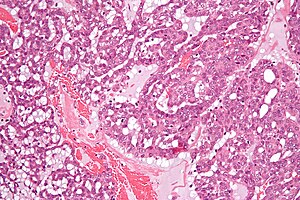Polymorphous adenocarcinoma
Jump to navigation
Jump to search
The printable version is no longer supported and may have rendering errors. Please update your browser bookmarks and please use the default browser print function instead.
| Polymorphous adenocarcinoma | |
|---|---|
| Diagnosis in short | |
 PLGA. H&E stain. | |
|
| |
| LM | low-grade cytology - nuclei ovoid & small, small nucleoli, powdery chromatin (papillary thyroid carcinoma-like appearance); eosinophilic cytoplasm; variable architecture - often small nests, classically has whorling ("eye-of-storm") pattern and single file pattern |
| LM DDx | adenoid cystic carcinoma, pleomorphic adenoma, cribriform adenocarcinoma of the minor salivary gland |
| IHC | S-100 +ve, CK7 +ve, vimentin +ve |
| Site | oral cavity, salivary gland |
|
| |
| Prevalence | uncommon (varies by study) |
| Prognosis | good |
Polymorphous low-grade adenocarcinoma, abbreviated PLGA, is a rare malignant salivary gland tumour.
General
- Female:male ~= 2:1.
- Older people ~50-70 years old.
- Large variably in the prevalence reported - suggests a lacking of reproducibility in the diagnosis.[1]
- Slow growing - metastases rare - prognosis good.[2][3]
Gross
- Tumour of the minor salivary glands.[4]
- Almost exclusively in the oral cavity - usually palate.[2]
Microscopic
Features:[5]
- Architecture: often small nests, may be targetoid.
- Classically has whorling with eye-of-storm & single file.
- Cytologically monotonous (uniform) with variable architecture - key feature.
- Nucleus: ovoid & small, small nucleoli, powdery chromatin.
- Papillary thyroid carcinoma-like appearance.
- Cytoplasm: eosinophilic.
- Nucleus: ovoid & small, small nucleoli, powdery chromatin.
- Indistinct cell borders.
Note:
- Always a low-grade tumour - by definition.
DDx:
- Adenoid cystic carcinoma.
- Pleomorphic adenoma.
- Cribriform adenocarcinoma of the minor salivary gland.[6]
Images
IHC
Features:[1]
- S-100 +ve.
- CK7 +ve.
- Vimentin +ve.
Others:
- GFAP +ve/-ve.
- BCL2 +ve/-ve.
- Generally negative for myoepithelial markers (calponin, actin) - useful if negative.
See also
References
- ↑ 1.0 1.1 de Araujo, VC.; Passador-Santos, F.; Turssi, C.; Soares, AB.; de Araujo, NS. (2013). "Polymorphous low-grade adenocarcinoma: an analysis of epidemiological studies and hints for pathologists.". Diagn Pathol 8: 6. doi:10.1186/1746-1596-8-6. PMID 23320410.
- ↑ 2.0 2.1 Paleri, V.; Robinson, M.; Bradley, P. (Apr 2008). "Polymorphous low-grade adenocarcinoma of the head and neck.". Curr Opin Otolaryngol Head Neck Surg 16 (2): 163-9. doi:10.1097/MOO.0b013e3282f70441. PMID 18327037.
- ↑ Fife, TA.; Smith, B.; Sullivan, CA.; Browne, JD.; Waltonen, JD.. "Polymorphous low-grade adenocarcinoma: a 17 patient case series.". Am J Otolaryngol 34 (5): 445-8. doi:10.1016/j.amjoto.2013.03.012. PMID 23618791.
- ↑ Andreu-Barasoain, M.; Vicente-Martín, FJ.; Gómez de la Fuente, E.; Salamanca-Santamaría, J.; Pampín-Franco, A.; López-Estebaranz, JL. (2013). "Polymorphous low-grade adenocarcinoma in the upper lip: a well-described but infrequently recognized tumor.". Dermatol Online J 19 (8): 19265. PMID 24021444.
- ↑ Humphrey, Peter A; Dehner, Louis P; Pfeifer, John D (2008). The Washington Manual of Surgical Pathology (1st ed.). Lippincott Williams & Wilkins. pp. 74. ISBN 978-0781765275.
- ↑ Skalova, A.; Sima, R.; Kaspirkova-Nemcova, J.; Simpson, RH.; Elmberger, G.; Leivo, I.; Di Palma, S.; Jirasek, T. et al. (Aug 2011). "Cribriform adenocarcinoma of minor salivary gland origin principally affecting the tongue: characterization of new entity.". Am J Surg Pathol 35 (8): 1168-76. doi:10.1097/PAS.0b013e31821e1f54. PMID 21716087.

